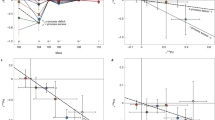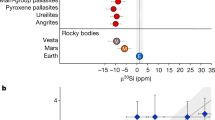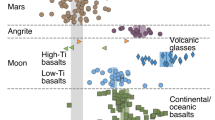Abstract
Isotopes of heavy elements are produced in various amounts by nuclear processes in stars1,2. Consequently, the presence of isotopic anomalies in the Solar System is considered to reflect the presence of presolar grains condensed in previous generations of stars3 and not a (proto-) Solar System process. However, for oxygen, the major rock-forming element, it has been shown that physico-chemical reactions applicable to the presolar cloud or the protoplanetary disk were a possible source of isotopic variations due to mass-independent isotopic fractionation (MIF)4,5. Here we show that MIF effects are not restricted to oxygen, but can also be produced for titanium. Titanium-rich grains experimentally condensed from a TiCl4(g)/C5H12(g) plasma exhibit MIF effects from −25% to +120% for all Ti isotopic ratios. These large Ti isotopic variations follow the model developed for oxygen MIF6 and mimic the Ti isotopic anomalies observed in some presolar grains. This effect is ascribed to the reactions between chemically indistinguishable isotopes6 and could contribute to the complexity of isotopic anomalies observed in Solar System materials1,7,8,9,10,11,12,13,14.
This is a preview of subscription content, access via your institution
Access options
Access Nature and 54 other Nature Portfolio journals
Get Nature+, our best-value online-access subscription
$29.99 / 30 days
cancel any time
Subscribe to this journal
Receive 12 digital issues and online access to articles
$119.00 per year
only $9.92 per issue
Buy this article
- Purchase on Springer Link
- Instant access to full article PDF
Prices may be subject to local taxes which are calculated during checkout




Similar content being viewed by others
Data availability
The data that support the plots within this paper and other findings of this study are available in the Supplementary Information or from the corresponding author upon reasonable request.
References
Dauphas, N. & Schauble, E. A. Mass fractionation laws, mass-independent effects, and isotopic anomalies. Annu. Rev. Earth Planet. Sci. 44, 709–783 (2016).
Birck, J. L. An overview of isotopic anomalies in extraterrestrial materials and their nucleosynthetic heritage. Rev. Mineral. Geochem. 55, 25–64 (2004).
Clayton, R. N., Grossman, L. & Mayeda, T. K. A component of primitive nuclear composition in carbonaceous meteorites. Science 182, 485–488 (1973).
Thiemens, M. H. & Heidenreich, J. E. The mass-independent fractionation of oxygen—a novel isotope effect and its possible cosmochemical implications. Science 219, 1073–1075 (1983).
Thiemens, M. H. Introduction to chemistry and applications in nature of mass indepedendent isotope effects special feature. Proc. Natl Acad. Sci. USA 110, 17631–17637 (2013).
Reinhardt, P. & Robert, F. On the mass independent isotopic fractionation in ozone. Chem. Phys. 513, 287–294 (2018).
Zinner, E. K. et al. NanoSIMS isotopic analysis of small presolar grains: search for Si3N4 grains from AGB stars and Al and Ti isotopic compositions of rare presolar SiC grains. Geochim. Cosmochim. Acta 71, 4786–4813 (2007).
Ireland, T. R., Zinner, E. K. & Amari, S. Isotopically anomalous Ti in presolar SiC from the Murchison meteorite. Astrophys. J. 376, L53–L56 (1991).
Huss, G. R. & Smith, J. B. Titanium isotopic compositions of well-characterized silicon carbide grains from Orgueil (CI): implications for s-process nucleosynthesis. Meteor. Planet. Sci. 42, 1055–1075 (2007).
Leya, I., Schönbächler, M., Wiechert, U., Krähenbühl, U. & Halliday, A. Titanium isotopes and the radial heterogeneity of the solar system. Earth Planet. Sci. Lett. 266, 233–244 (2008).
Trinquier, A. et al. Origin of nucleosynthetic isotope heterogeneity in the solar protoplanetary disk. Science 324, 374–376 (2009).
Davis, A. M. et al. Titanium isotopes and rare earth patterns in CAIs: evidence for thermal processing and gas-dust decoupling in the protoplanetary disk. Geochim. Cosmochim. Acta 221, 275–295 (2018).
Gyngard, F., Amari, S., Zinner, E. K. & Marhas, K. K. Correlated silicon and titanium isotopic compositions of presolar SiC grains from the Murchison CM2 chondrite. Geochim. Cosmochim. Acta 221, 145–161 (2018).
Nguyen, A. N., Nittler, L. R., Alexander, C. M. O. ’D. & Hoppe, P. Titanium isotopic compositions of rare presolar SiC grain types from the Murchison meteorite. Geochim. Cosmochim. Acta 221, 162–181 (2018).
Young, E. D., Galy, A. & Nagahara, H. Kinetic and equilibrium mass-dependent isotope fractionation laws in nature and their geochemical and cosmochemical significance. Geochim. Cosmochim. Acta 66, 1095–1104 (2002).
Tartese, R., Chaussidon, M., Gurenko, A., Delarue, F. & Robert, F. Insights into the origin of the carbonaceous chondrite organics from their triple oxygen isotope composition. Proc. Natl Acad. Sci. USA 115, 8535–8540 (2018).
Kööp, L. et al. A link between oxygen, calcium and titanium isotopes in 26Al-poor hibonite-rich CAIs from Murchison and implications for the heterogeneity of dust reservoirs in the solar nebula. Geochim. Cosmochim. Acta 189, 70–95 (2016).
Yurimoto, H. & Kuramoto, K. Molecular cloud origin for the oxygen isotope heterogeneity in the solar system. Science 305, 1763–1766 (2004).
Lodders, K. Titanium and vanadium chemistry in low-mass dwarf stars. Astrophys. J. 577, 974–985 (2002).
Reinhardt, P. & Robert, F. Mass independent isotope fractionation in ozone. Earth Planet. Sci. Lett. 368, 195–203 (2013).
Robert, F. et al. Hydrogen isotope fractionation in methane plasma. Proc. Natl Acad. Sci. USA 114, 870–874 (2017).
Robert, F. The common property of isotopic anomalies in meteorites. Astron. Astrophys. 415, 1167–1176 (2004).
Marcus, R. A. Mass-independent isotope effect in the earliest processed solids in the solar system: a possible chemical mechanism. J. Chem. Phys. 121, 8201–8211 (2004).
Gao, Y. Q. & Marcus, R. A. On the theory of the strange and unconventional isotopic effects in ozone formation. J. Chem. Phys. 116, 137–154 (2002).
Babikov, D. Recombination reactions as a possible mechanism of mass-independent fractionation of sulfur isotopes in the Archean atmosphere of Earth. Proc. Natl Acad. Sci. USA 114, 3062–3067 (2017).
Murphy, A. B. Formation of titanium nanoparticles from a titanium tetrachloride plasma. J. Phys. D 37, 2841 (2004).
Biron, K., Derenne, S., Robert, F. & Rouzaud, J. N. Toward an experimental synthesis of the chondritic insoluble organic matter. Meteor. Planet. Sci. 50, 1408–1422 (2015).
Janssen, C., Guenther, J., Mauersberger, K. & Krankowsky, D. Kinetic origin of the ozone isotope effect: a critical analysis of enrichments and rate coefficients. Phys. Chem. Chem. Phys. 3, 4718–4721 (2001).
Schinke, R. & Fleurat-Lessard, P. The effect of zero-point energy differences on the isotope dependence of the formation of ozone: a classical trajectory study. J. Chem. Phys. 122, 094317 (2005).
Ivanov, M. V. & Babikov, D. On molecular origin of mass-independent fractionation of oxygen isotopes in the ozone forming recombination reaction. Proc. Natl Acad. Sci. USA 110, 17708–17713 (2013).
Acknowledgements
F.R. acknowledges support (Overheads) of ERC Advanced Grant PaleoNanoLife (PI: F.R.; grant. no. 161764). R.T. acknowledges support from the UK Science and Technology Facilities Council (grant no. ST/P005225/1). At The University of Manchester, the NanoSIMS was funded by UK Research Partnership Investment Funding (UKRPIF) Manchester RPIF Round 2, and the installation of a Hyperion RF plasma ion source was supported by the Henry Royce Institute for Advanced Materials, funded through EPSRC grant nos EP/R00661X/1, EP/P025021/1 and EP/P025498/1. M.C. acknowledges support from ANR Cradle (grant no. ANR-15-CE31-0004-01).
Author information
Authors and Affiliations
Contributions
F.R. designed the project and provided samples for this study. R.T. collected and analysed the NanoSIMS data. F.R., R.T., Z.D. and M.C. interpreted the cosmochemistry results and wrote the paper. G.L. interpreted the plasma physics results. B.D. and M.R. obtained and interpreted the microscopic images. P.R. participated in the interpretation of the Ti-MIF effects in terms of theoretical physics.
Corresponding author
Ethics declarations
Competing interests
The authors declare no competing interests.
Additional information
Peer review information Nature Astronomy thanks Andrew Davis, Justin Simon and the other, anonymous, reviewer(s) for their contribution to the peer review of this work.
Publisher’s note Springer Nature remains neutral with regard to jurisdictional claims in published maps and institutional affiliations.
Supplementary information
Supplementary Information
Supplementary Figs. 1–6, Table 1, discussion and references.
Supplementary Data
Excel version of Supplementary Table 1.
Rights and permissions
About this article
Cite this article
Robert, F., Tartèse, R., Lombardi, G. et al. Mass-independent fractionation of titanium isotopes and its cosmochemical implications. Nat Astron 4, 762–768 (2020). https://doi.org/10.1038/s41550-020-1043-1
Received:
Accepted:
Published:
Issue Date:
DOI: https://doi.org/10.1038/s41550-020-1043-1



